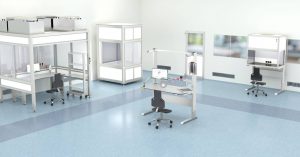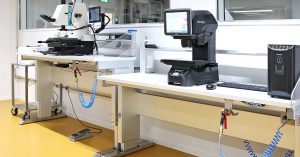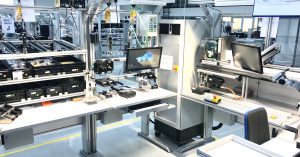Functionality over flashy colours – by using more than 2500 fixtures with item components to fit out its new production halls in Berlin, Siemens Energy is proving that aesthetics and design can be perfectly combined with functionality.
What do the art world, fashion and interior design have in common? They all rely on a perfect combination of colours and shapes to achieve aesthetic ideals. Yet, as the saying goes, beauty is in the eye of the beholder. As far as Siemens Energy Global GmbH & Co. KG is concerned, simple and elegant designs can be impressive, too. When the company came to fit out its production halls in Berlin-Spandau, it was looking for a style that would not distract from the main purpose – production – but instead would be packed with impressive functionality. In the search for a supplier who could combine flexibility with discreet design, the electrical engineering specialists chose our modular profile technology. This has since proved its worth in the halls over many years, and now Siemens Energy is planning its next step towards more sustainable production, with the construction of a new manufacturing facility for vacuum interrupters. This is giving rise to new requirements that the company is again intending to meet using item components.
Sustainable production
In 2020, Siemens Energy was spun off from Siemens AG to form an independent entity. The company is now one of the world’s leading manufacturers of energy technology. Its product portfolio includes a range of products, solutions and services for generating, transmitting and storing electrical energy. Siemens Energy employs a workforce of around 93,000 people worldwide. Just under 2400 of these work in the plant in Berlin-Spandau, where the electrical engineering specialists produce cutting-edge switchgear in several production halls. Its latest products are vacuum interrupters, which are insulated with chemically pure air rather than climate-damaging sulphur hexafluoride (SF6). As is standard in the whole Berlin switchgear plant, the cutting-edge production facility is supplied exclusively with electricity from renewable sources.
We gradually started making our work benches, racks and mobile transport trolleys from item components, which aren’t just more stable, but are also simpler and more elegant.
Even during construction of the first production halls on the site, the focus was on flexibility, sustainability and an appropriate design. The supplier originally chosen by Siemens Energy could not meet these requirements. “The design of these systems didn’t fit with our production operations, they were unable to adapt flexibly to production changes and they had functional weaknesses. We therefore gradually started making our work benches, racks and mobile transport trolleys from item components, which aren’t just more stable, but are also simpler and more elegant,” says Ingo Hopsch, Industrial Engineering at Siemens Energy. Over the years, the item Building Kit System proved its worth, which made the decision to fit out the new production hall with item components all the easier. More than 2500 fixtures that include item products are currently registered at the Berlin-Spandau site – from storage solutions and work bench systems to racks and entire production lines. Siemens Energy even uses an aluminium profile from item for a control panel in its own product portfolio.
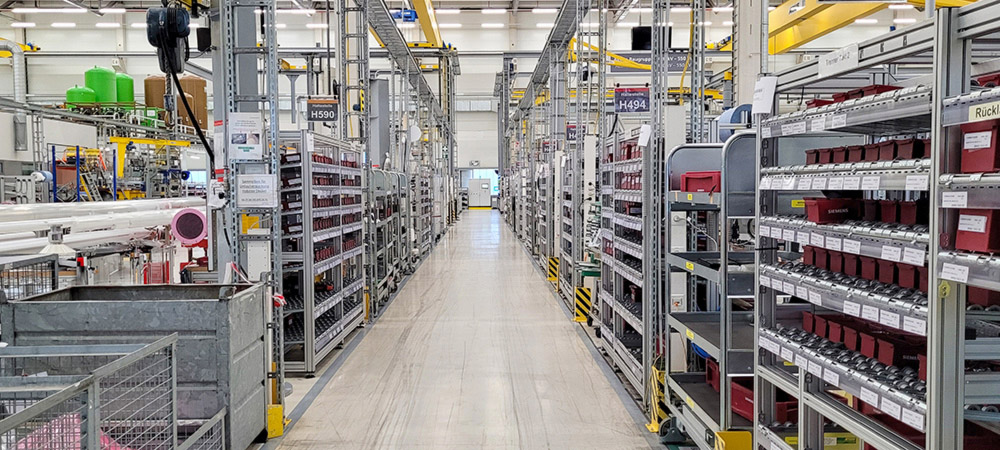
Standardised production and protection
For Siemens Energy, one key advantage of the item components is the modular Building Kit System. To maintain the efficiency of the production lines, the company frequently makes modifications that would be impossible with conventional systems. For example, if a department needs an additional work bench or attachment, all they have to do is let the workshop know, and the team there will then develop and build the necessary solutions. The workshop itself has a footprint of 75 m2 and its own material store, holding both new components using prefabricated or cut-to-size profiles and reusable profiles from disassembled work benches on pallet racks.
After all, as much as 75 percent of previously used parts can be used again after disassembly – something that can’t be said of our competitors’ products. Whereas benches and racks were previously built in different shapes and sizes for production, there is now a standard work bench that can be adapted to different requirements. “This standard work bench has set dimensions and can be seamlessly integrated into new or modified lines,” says Thomas Wendt from Operative Maintenance at Siemens Energy. “When necessary, the system is adapted to the space available.” As a result, work benches can be reused, and staff can quickly find their way around when they move to a new work bench.
The standard work bench has set dimensions and can be seamlessly integrated into new or modified lines.
In addition to their flexibility, the components also provide the necessary protection when working with electricity, which is a day-to-day occurrence for the staff at Siemens Energy. Potential equalisation is possible with item components, which dissipate electrical energy directly into the earth via secure connections. This not only protects staff members, but also protects sensitive components from damage resulting from electrostatic discharge (ESD) at the same time. In addition, Siemens Energy uses item profiles made from a wood-plastic compound. Thanks to the high proportion of wood, these do not conduct electricity, and can be used for special tests or working with high voltages. Another plus point is that they are much lighter than standard aluminium profiles.
Perfect dimensions at the push of a button
Thanks to the collaboration with item, Siemens Energy was able to boost its performance in a whole range of production processes significantly. For example, cable assembly used to be carried out directly at the high-voltage circuit breaker. For employees, this meant constantly moving between the rack and the circuit breaker to assemble the cables. Our components made it possible to minimise this to-ing and fro-ing, cutting the work time by as much as 40 percent. The cable harness is prefabricated on a special construction made from item profiles and then installed on the circuit breaker as a complete harness. Ingo Hopsch sums up the situation: “Our circuit breakers can be up to 10 metres long. Staff used to have to cover this distance multiple times to install the cables, but now all they have to do is take over the ready-assembled cable harness.” A team has been specially formed to regularly analyse processes and identify optimisation potential such as this on an ongoing basis. With regular training from item, productivity is also to be improved further as part of a continuous improvement process, providing optimum support for the workshop.
Meanwhile, the item Engineeringtool offers a helpful platform for developing and manufacturing new fixtures. This software can depict 3D models, display technical drawings with all the relevant dimensions and deliver easily accessible assembly guides. This represents major added value for Siemens Energy, since even employees from departments other than the workshop can design new solutions. With the help of the in-built archiving system, anyone and everyone can access specific fixtures digitally and work on them. At the same time, the tool supplies CAD data that can easily be exported, integrated into the in-house CAD system and worked on more there.
Our circuit breakers can be up to 10 metres long. Staff used to have to cover this distance multiple times to install the cables, but now all they have to do is take over the ready-assembled cable harness.
Currently, Siemens Energy is busy gutting and renovating the production halls at the site. Ultimately, the new production hall is set to include a cleanroom that will house an exceptional production process for vacuum tubes. Whereas highly toxic sulphur hexafluoride (SF6) is normally used as an insulating, switching and extinguishing gas in switchgear, the company has been able to eliminate this from its production completely. SF6 is a strong greenhouse gas that accumulates in the atmosphere. One kilogram of SF6 inflicts the same damage on the climate as more than 25,000 kilograms of CO2. Siemens Energy uses purified air as an environmentally friendly alternative to this climate-damaging gas. When it came to fitting out this production hall, the electrical engineering specialist once again turned to item – specifically, for our comprehensive range of cleanroom components.
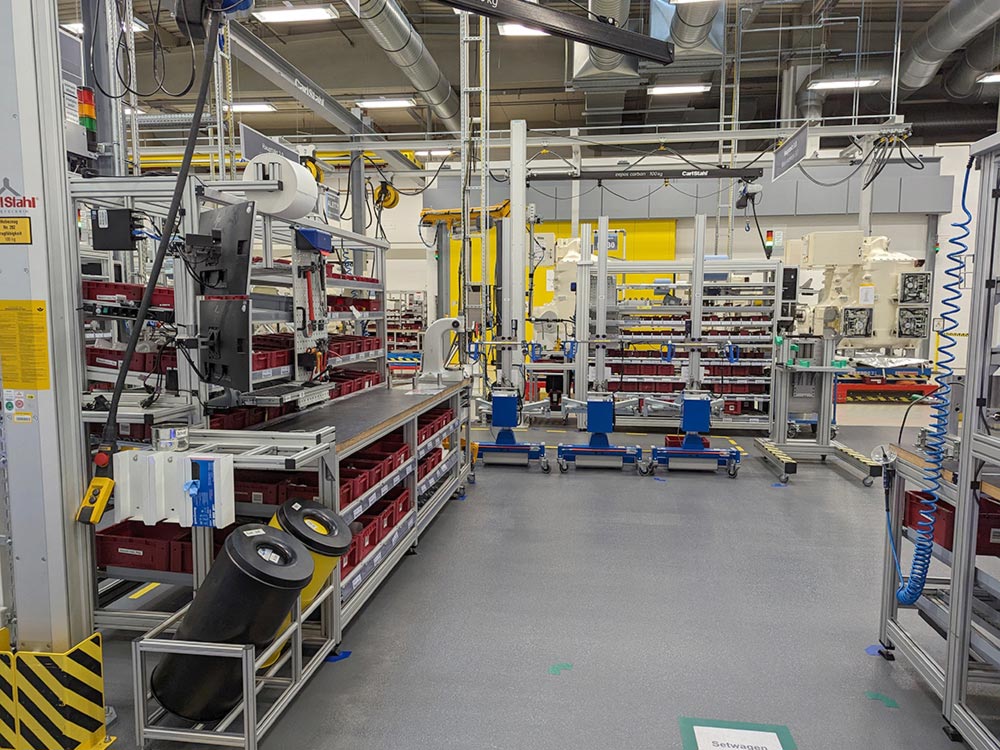
Do you want to keep up to date on the various ways that item products are being put to use? Then we have just what you’re looking for! Simply subscribe to the item blog by completing the box at the top right.




